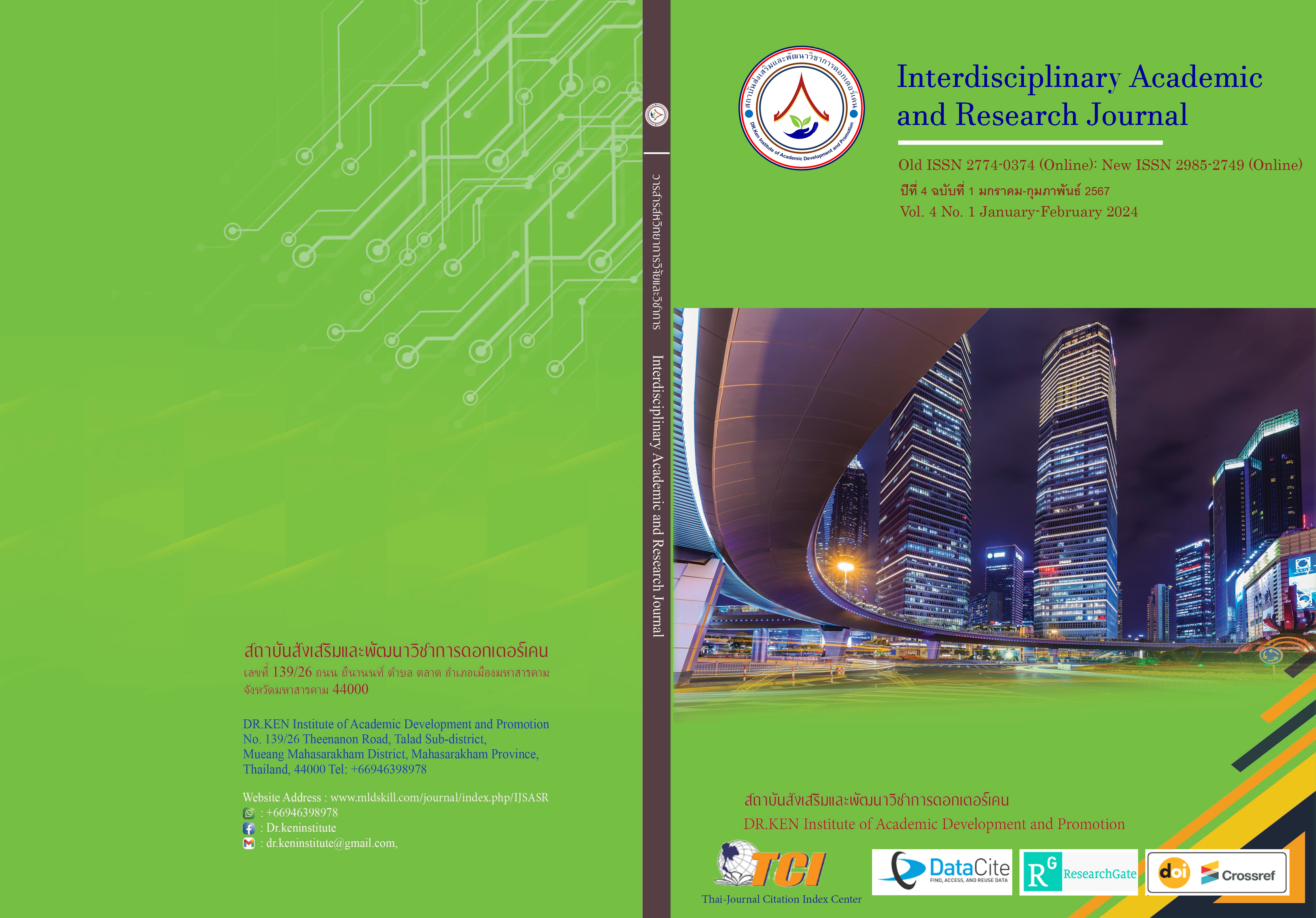Adaptation of Service for Prevention and Control of Non-communicable Disease in COVID–19 Situation, Regional Health 9
DOI:
https://doi.org/10.60027/iarj.2024.274787Keywords:
Adaptation; , Non-communicable Disease; , COVID-19 situationAbstract
Background and Aims: In 2020, there was an outbreak of the coronavirus disease 2019 (COVID-19) throughout the world, spreading the infection rapidly, including Thailand, causing a large number of patients and deaths, which is especially in the group of patients who are at risk of violence and death. Elderly people, people with chronic diseases such as high blood pressure, diabetes, cardiovascular disease, obesity, chronic kidney disease, and people receiving immunosuppressive medications. The public health service system must be adjusted to have the least impact on access to treatment. Thus, the objectives of this research were to study adapting service models for the prevention and control of non-communicable diseases. Including studying factors affecting innovation in providing services and evaluating the sustainability of innovative services for the prevention and treatment of non-communicable diseases In the situation of the COVID-19 outbreak at Health Region 9.
Methodology: Data were collected between 18 June and 1 September 2021. The sample group consisted of executives and those responsible for non-communicable diseases from the provincial and district levels. Consist of Nakhon Ratchasima Provincial Public Health Office and Phimai District about 8 people and 11 people from Buriram Provincial Public Health Office, Khu Mueang Hospital, Prakhon Chai Hospital, Nong Hong Hospital and Lahan Sai Hospital, totaling 19 people. The instrument used was semi-structured questions. Gather information through interviews and group discussions. Data were analyzed by descriptive statistics.
Results: The service patterns had innovative development of information technology systems to help take care of people at risk/sick groups with non-communicable diseases. Factors affecting innovation were leaders who integrated health systems, supported budgets, and personnel, and developed information technology systems to assist operations. Innovation results should be expanded so that people can access them and include leading the policy to develop the service system by the reform plan of Participatory Health Region. Operated by the participatory health region management about Smart NCDs R9 Plus: Digital Health station, under the strategic plan of the provincial, district, and sub-district levels. Region Health Provider should be pushing this policy for implementation of innovations to other provincial in the health area to be continue and sustainable.
Conclusion: The study highlights the innovative development of information technology systems in healthcare services, particularly focusing on non-communicable diseases and at-risk populations. Leadership integration, budgetary support, and technological infrastructure are identified as crucial factors influencing these advancements. The findings emphasize the importance of expanding and sustaining these innovations, advocating for policy leadership through Participatory Health Region reform, and encouraging widespread implementation across various provinces in the healthcare sector.
References
กระทรวงสาธารณสุข. (2563). แนวทางปฏิบัติด้านสาธารณสุขเพื่อการจัดการภาวะการระบาดของโรคโควิด19 ในข้อกำหนดออกตามความในมาตรา 9 แห่งพระราชกำหนดการบริหารราชการ ในสถานการณ์ฉุกเฉิน พ.ศ. 2548 (ฉบับที่ 1) 3 เมษายน 2563. Retrieved on 6 January 2021 from : www.covid-19.moph.go.th
กองโรคไม่ติดต่อ กรมควบคุมโรค กระทรวงสาธารณสุข. (2562). รายงานสถานการณ์โรค NCDs เบาหวาน ความดันโลหิตสูง และปัจจัยเสี่ยงที่เกี่ยวข้อง พ.ศ. 2562. กรุงเทพฯ : กองโรคไม่ติดต่อ กรมควบคุมโรค กระทรวงสาธารณสุข.
ชนินทร์ภร เต็มรัตน์ และ พินทุ สุวรรณมณี. (2559). การรับรู้ภาวะสุขภาพและคุณภาพการบริการตามการรับรู้ของผู้รับบริการการตรวจสุขภาพประจำปี โรงพยาบาลสงขลานครินทร์. วารสารพยาบาลสงขลานครินทร์. 36(2), 148-158.
รัตนา เสนาหนอก. (2566). การศึกษาผลของโรงเรียนเบาหวานสามัคคีต่อพฤติกรรมการจัดการตนเองความพึงพอใจในการรับบริการและระดับน้ำตาลสะสมในเลือดของผู้ป่วยเบาหวานประเภท 2 ที่ควบคุมระดับ- น้ำตาลไม่ได้. วารสารการแพทย์โรงพยาบาลศรีสะเกษ สุรินทร์ บุรีรัมย์. 38 (2), 533-544.
ศูนย์ปฏิบัติการภาวะฉุกเฉิน กรมควบคุมโรค. (2563). รายงานสถานการณ์โรคปอดอักเสบจากการติดเชื้อไวรัสโคโรนาสายพันธุ์ใหม่ ฉบับที่ 7 วันที่ 10 มกราคม 2563. Retrieved on December 25, 2020 from: https://ddc.moph.go.th/viralpneumonia/file/situation/situation-no49-100163.pdf
ศูนย์ปฏิบัติการภาวะฉุกเฉิน กรมควบคุมโรค.(2563). รายงานสถานการณ์โรคปอดอักเสบจากการติดเชื้อไวรัสโคโรนาสายพันธุ์ใหม่ ฉบับที่ 25 วันที่ 28 มกราคม 2563. Retrieved on December 25, 2020 from: https://ddc.moph.go.th/viralpneumonia/file/situation/situation-no49-280163.pdf
อัจฉรา ว่องไวโรจน์. (2548). การศึกษาปัจจัยที่มีความสัมพันธ์ต่อการตรวจสุขภาพประจำปีของพนักงานบริษัทประกันชีวิต. ปริญญานิพนธ์ วท.ม.(สุขศึกษา): บัณฑิตวิทยาลัย มหาวิทยาลัยศรีนครินทรวิโรฒ
Centers for Disease Control and Prevention. (2021). COVID-19 and Your Health. Retrieved from https://www.cdc.gov/coronavirus/2019-ncov/daily-life-coping/managing-stress-anxiety.html
World Health Organization. (2020). COVID-19: Operational guidance for maintaining essential health services during an outbreak. Retrieved from https://www.who.int/emergencies/diseases/novel-coronavirus-2019/technical-guidance/maintaining-essential-health-services
Downloads
Published
How to Cite
Issue
Section
License
Copyright (c) 2024 Prempree Chawananoraset , Parichat Chitklang

This work is licensed under a Creative Commons Attribution-NonCommercial-NoDerivatives 4.0 International License.
Copyright on any article in the Interdisciplinary Academic and Research Journal is retained by the author(s) under the under the Creative Commons Attribution-NonCommercial-NoDerivatives 4.0 International License. Permission to use text, content, images, etc. of publication. Any user to read, download, copy, distribute, print, search, or link to the full texts of articles, crawl them for indexing, pass them as data to software, or use them for any other lawful purpose. But do not use it for commercial use or with the intent to benefit any business.
















.png)


